本试题 “短文改错。假定英语课上老师要求同桌之间交换修改作文,请你修改你同桌写的以下作文。文中共有10处语言错误,每句中最多有两处。每处错误涉及一个单词的增加...” 主要考查您对名词
物主代词
不定代词
形容词的比较级
形容词
介词和介词短语
并列连词
一般过去时
主谓一致
等考点的理解。关于这些考点您可以点击下面的选项卡查看详细档案。
- 名词
- 物主代词
- 不定代词
- 形容词的比较级
- 形容词
- 介词和介词短语
- 并列连词
- 一般过去时
- 主谓一致
名词的概念:
名词(Nouns)是词性的一种,也是实词的一种,是指代人、物、事、时、地、情感、概念等实体或抽象事物的词。名词可以独立成句。在短语或句子中通常可以用代词来替代。名词可以分为专有名词(ProperNouns)和普通名词(CommonNouns),普通名词又可分为不可数名词和可数名词两大类。
名词的数:
1、名词复数的构成方法:
(1)在一般情况下,加词尾-s: book/books书 pen/pens钢笔 face/faces脸
(2)以s, x, z, sh, ch等结尾的名词,通常加词尾-es:bus/buses 公共汽车 box/boxes 盒子 dish/dishes 盘子
注:有些以ch结尾的名词,由于其发音不是[k]而是[tf],那么其复数形式应加词尾–s,如stomach/stomachs胃。
(3)以y结尾的名词,其复数构成要分两种情况:以“辅音字母+y”结尾的名词,将y改为ies;以“元音字母+y”结尾的名词,直接加词尾s:city/cities 城市 boy/boys 男孩 key/keys 钥匙
注:以y结尾的专有名词,若在某些特殊情况下需要复数,通常加s构成: Mary/Marys玛丽 Germany/Germanys德国
(4)以o结尾的名词,有些加词尾-s,有些加-es,有些加-s或-es均可: piano/pianos钢琴 tomato/tomatoes西红柿 zero/zero(e)s零
注:有人对英语中所有以o结尾的名词作了统计,一共近200个,其中绝大部分的复数形式通过加词尾-s构成,少数加词尾es。在中学英语范围内,加词尾es的主要有以下4个:
tomato西红柿,potato土豆,hero英雄,Negro黑人
(5)以f或fe结尾的名词,也有两种可能:即有些直接加词尾-s,有些则把f/fe改为ves: chief/chiefs首领 roof/roofs屋顶 knife/knives小刀
注:在中学英语范围内,要改f/fe为ves的只有以下10个词(它们都是日常生活中的常用词):
wife 妻子,life 生命,knife 小刀,leaf 树叶,thief 贼,half 一半,self 自己,shelf 架子,loaf 面包,wolf 狼。
另外,中学英语中的handkerchief(手帕)一词的复数有两种形式:handkerchiefs/handkerchieves,但在现代英语中,以用handkerchiefs为多见。
2、单数与复数同形式的名词:
中学英语中主要的有:sheep绵羊,fish鱼,deer鹿,Chinese中国人,Japanese日本人,Portuguese葡萄牙人,Swiss瑞士人,aircraft飞行器,means方法,series系列,head(牛等的)头数,works工厂,等。
注:fish有时也用fishes这样的复数形式,尤其表示种类时;
head若不是牲口的“头数”,而是表示“人的头”或“人数”,则要用heads这样的复数形式。
3、不规则的复数名词:
有的名词单数变复数时,没有一定的规则:
man/men男人 woman/women女人 child/children小孩 tooth/teeth牙齿 foot/feet脚 goose/geese鹅 mouse/mice老鼠 ox/oxen公牛
注:
(1)一些以man,woman结尾的合成词,在构成复数与man,woman的变化形式相同,如:
policeman/policemen警察,gentleman/gentlemen绅士,Englishman/Englishmen英国人,等等。但是human(人),German(德国人)不是合成词,其复数不能仿man的变化规律,而是按规则变化,即用humans,Germans。
(2)foot表示“英尺”时,其复数可以有两种形式feet/foot,如:
He is about six feet/foottall. 他大约6英尺高。
名词可数性的三个易错点:
(1)根据汉语习惯将英语的物质名词误认为是可数名词。如:
汉语中的“面包”,一般认为是可数的,可以说“一个面包”、“两个面包”等,但英语中的bread却通常是不可数的,不能相应地用a bread,two breads表示以上意思。不过有趣的是,loaf 表示“面包”却又是可数的,可说a loaf, two loaves。
(2)想当然地判断名词的可数性。如:
有的学生认为news (消息)和paper (纸)都不可数,于是便想当然地认为 newspaper (报纸)就一定不可数,但事实上,newspaper却是可数名词;又如:
有的同学认为 tear (眼泪)即“泪水”,并将其与water(水)相联系,认为tear 是不可数的,但事实上,tear却是可数的。
(3)受名词一词多义的影响。有的名词不止一个意思,且用于不同意思时,其可数性也有不同,不要形成思维思势。如:
aim表示“目的”时是可数名词,表示“瞄准”时是不可数名词;又如 experience表示“经验”时不可数,表示“经历”时则可数;再如:
fortune,当它表示“运气”时,不可数(=luck),当它表示“命运”时,可数,当它表示“财产”时,不可数,但可与a连用。
可数与不可数名词的常用修饰语:
(1)修饰可数名词的常用修饰语有:
these, those, few, a few, many, a good[great] many, agreat[good]number of 等。
注:a good[great]many后直接跟名词,没有介词of。
(2)修饰可数名词的常用修饰语有:
this, that, a few, a little, a bit of, much, no, a great deal of 等。
(3)有些修饰语既可修饰可数名词也可修饰不可数名词:
all, some, enough, a lot of, lots of, plenty of, a large amount of, a large quantity of等。
(4)有些名词形式上是复数,但却被用作不可数名词,使用much, little等修饰语:
He hasn't got much brains.他没什么头脑。
He took much pains to do the work. 他费了不少心做这工作。
I said I wouldn't want much wages. 我说过我不要很多工资。
It's high time you were taught a little manners.该是你学一点礼貌的时候了。
单位词与不可数名词数量表示法:
单位词是表示事物个体性的词语,不可数名词通常没有复数形式,也不可以用个数计算,要表示不可数名词的个体性需借助单位词:
a piece of paper一张纸
a piece of advice一条建议
a piece of news一条消息
an article of furniture一件家具
a cake of soap一块香皂
a slice of meat一块
a cup of tea一杯茶
a bottle of ink一瓶墨水
注:不要按汉语习惯在不该用单位词的地方错用单位词,如“一张邮票”只能说a stamp,而不能说a piece of stamp。
名词的可数性:
1、名词根据其可数性,可分为可数名词与不可数名词。一般说来,个体名词和大部分集合名词是可数的;而专有名词、物质名词、抽象名词以及少部分集合名词则通常是不可数的。但是这种区分只是大致的,原则性的,并不是绝对的。英语有些名词往往既是可数也可以是不可数的。
A:Would you like a cake? 要吃块蛋糕吗?
B:No, I don't like cake.不吃,我不喜欢吃蛋糕。
以上第一句用a cake,这是把cake视为一块一块的“蛋糕”,所以它是可数的;而第二句只用cake,这是把它当作物质名词看待,所以它成了不可数名词。
2、不同类别名词的可数性。
(1)专有名词的可数性。
在通常情况下,专有名词具有“独一无二”的含义,因此它通常没有复数形式,即不可数。但是,专有名词的独一无二性通常是相对的,随着范围的扩大,这种独一无二性便会受到破坏。
如在一个星期(week)内,只有一个星期六(Saturday),一个星期日(Sunday)等,但是在一个月中甚至一年中,便有多个星期六,多个星期日了。所以我们有时可以说:
We have spent many happy Sundays there. 我们在那儿度过了许多个愉快的星期日。
又如,在一个小范围内,可能只有一个Henry,但在一个较大的范围内则可能有多个Henry,因此我们有时会见到这样的句子:
There are five Henrys in our school. 我们学校有五个亨利。
另外,若专有名词转化成了普通名词,也可以是可数的:
Thousands of LeiFengs have emerged in China.中国涌现出了千千万万个雷锋。
(2)个体名词的可数性。
个体名词表示的是一个一个的人或物的个体,所以它通常是可数的。
(3)物质名词的可数性。
由于物质名词在通常情况下不能分为个体,所以它通常是不可数的。但是,在某些特殊情况下(如表示种类等),有些物质名词也可以连用不定冠词或用复数形式:
wine酒(不可数),a wine一种酒(可数), beer啤酒(不可数),two beers两杯啤酒(可数) ,glass玻璃(不可数),some glasses一些玻璃杯(可数)
(4)抽象名词的可数性。
抽象名词是表示事物性质、行为、状态、感情等抽象概念的,因此它通常是不可数的。但是,有时抽象名词也可转化为具体名词(可数),表示具有某种性质的人或事物:
success成功(不可数),asuccess成功的人或事(可数) ,pleasure愉快(不可数),apleasure令人愉快的人或事(可数)
(5)集合名词的可数性。集合名词表示若干个体组成的集合体,它本身通常是可数的,其复数形式表示多个集合体:
a family一个家庭,three families三个家庭 a team一个队,two teams两个队 a crowd一群人,crowds多群人
名词知识体系:
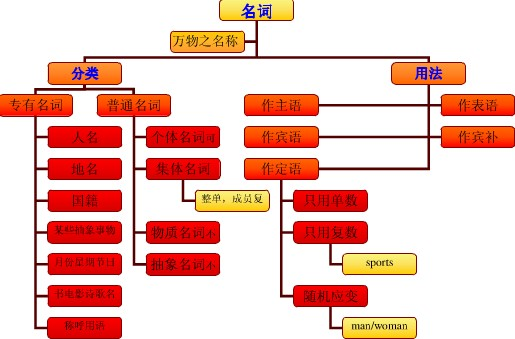
特殊名词的复数形式:
1、复合名词的复数形式。通常是将其主要名词变为复数:
passer-by/passers-by 过路人
shoe-maker/shoe-makers 鞋匠
looker-on/lookers-on 旁观者
on-looker/on-lookers 旁观者
father-in-law/fathers-in-law 岳父
若没有主要名词,则通常在最后一个词加s:
go-between/go-betweens中间人,
媒人 know-all/know-alls 万事通
注:由man/woman用于另一名词前构成的合成名词,两者均变为复数:
man doctor/men doctors男医生
woman writer/women writers 女作家
2、字母、文字、数字、符号等的复数形式。原则上加词尾-'s:
There are two i's in the word"skiing". skiing.这个词里有两个字母i。
如:Mind your p's and q's. 要谨言慎行。
All the–'s should be changed to+'s. 所有的正号应改为负号。
注:若不至于发生混淆,也可只加词尾s。
如:He was born in the 1930(')s. 他出生在20世纪30年代。
Your 3(')s look like 8(')s. 你写的3看起来像似8。
3、度量衡单位的缩写词的复数形式。
一般不加词尾-s:
m(meter, meters)米 km(kilometer, kilometers)千米 kg(kilogramme, kilogrammes)千克 cm(centimeter, centimeters)厘米;
有的缩写词也加s:
hr(hours)/hrs(hours)小时 No(number)/Nos(Numbers)号码;
有个别缩写词采用重复最后一个字母的方式构成复数形式:
p.10(page10)第10页 pp.10(pages10through15)第10至15页
物主代词的概念:
表示所有关系的代词叫物主代词。
物主代词有两种形式:一种是形容词性物主代词,在句中只能充当定语;另一种是名词性物主代词,和名词用法相同,在句中作主语、宾语、表语等。
物主代词的特性:
1、物主代词既有表示所属的作用又有指代作用。
例如:John had cut his finger;约翰割破了手指。
物主代词有形容词性(my,your等)和名词性(mine,yours等)两种,形容词性的物主代词属于限定词。
名词性的物主代词在用法上相当于省略了中心名词的“'s”属格结构,
如:Jack's cap 意为 The cap is Jack's.
His cap 意为 The cap is his.
2、名词性物主代词的句法功能:
a.作主语,例如:May I use your pen? Yours works better.
b.作宾语,例如:I love my motherland as much as you love yours.
c.作介词宾语,例如:Your should interpret what I said in my sense of the word,not in yours.
d.作主语补语,例如:The life I have is yours. It's yours. It's yours. 我的生命属于你,属于你,属于你。
物主代词的基本形式:
|
第一人称 |
第二人称 |
第三人称 | ||||
|
|
|
名词性 |
形容词性 |
名词性 |
形容词性 |
名词性 |
|
单数 |
my |
mine |
your |
yours |
his |
his |
|
复数 |
our |
ours |
your |
yours |
theirs | |
形容词性物主代词的用法:
1、形容词性物主代词通常修饰名词,作定语。
如:We should treat her mother very well.
2、与own连用表示强调。
如:I saw it with my own eyes.
名词性物主代词的用法:
1、名词性物主代词可作主语、表语和宾语。
如:This is my desk. Yours is over there.
2、名词性物主代词常用于双重属格,于of连用。
如:This girl is a friend of mine.
物主代词知识体系:
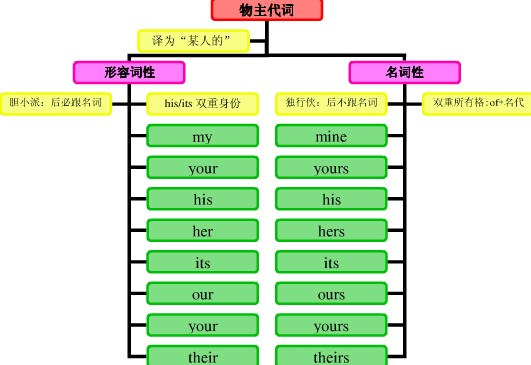
物主代词特别用法:
1、名词性和形容词性物主代词不能混用。
如:Jack has a low opinion of Sue.
2、物主代词的单复数必须和它所指代的名词一致。
如:His idea is to do more practice every day.
3、对于anyone,anybody,everyone,everybody,应根据上下文来判断his或her,有时也可用their。
如:Has everyone finished their work?
不定代词概说:
英语的不定代词有all, each, both, either, neither, one, none, little, few, many, much, other, another, some, any, no, few, little, both, enough, every等,以及由some,any,no和every构成的合成代词(即somebody, anyone, nothing等)。在这些不定代词中,多数都能作主语、宾语、表语或定语,但是代词none以及由some, any, no和every构成的合成代词只能作主语、宾语或表语,不能作定语,而no和every则只用作定语。
不定代词用法对比:
1、so little与such little的区别:
用so little还是such little取决于little的意思:若表示数量方面的“少”,则用so little;若表示形状体积的“小”,则用such little:
如:He has so little time for reading. 他读书的时间少得可怜。
I've never seen such little boxes. 我从未见过那样小的盒子。
2、some与any的用法区别:
一般说来,some用于肯定句中,any用于否定句和疑问句中。但是,在表示请求、邀请或征求意见的句子中,通常要用some而不用any:
如:Would you like some cake? 吃点蛋糕吗?
Why not buy some bread? 为什么不买些面包呢?
Shall I get some chalk for you? 要我帮你拿些粉笔来吗?
注:any有时也用于肯定句中,此时表示“任何”:
如:Any colour will do. 任何颜色都行。
Come any day you like. 随便哪天来都可以。
3、many与much的用法区别:
两者都表示“许多”,但many修饰或代替可数名词(复数),与few(少数)相对;
而much用来修饰或代替不可数名词(单数),与little(少量)相对。在口语中两者主要用于非肯定句中:
如:Did you see many people there? 你在那儿看见许多人了吗?
We don't have much time. 我们没有许多时间。
在肯定句中,一般用a lot of, lots of, plenty of 等代之。但在正式文体中有时也用于肯定句中;
另外,若用作主语或主语的定语,或其前有how, too, as, so, a good, a great等修饰,也可用于肯定句中:
如:Many of us left early. 我们有许多人离开得很早。
Much work has been done. 许多工作都已经做了。
You've given me too much. 你已给我太多了。
Take as many(much) as you want. 你要多少拿多少。
I asked her a great many questions. 我问了她许多问题。
4、few, a few与little, a little的用法区别:
(1)few和a few后接可数名词的复数形式。few表示数量很少或几乎没有,强调“少”,含有否定意义;
a few表示数量虽然少但毕竟还有,强调“有”,含有肯定意义:
如:It is very difficult, and few people understand it. 它很难,没有几个人能懂。
It is very difficult, but a few people understand it. 他虽难,但是有些人懂。
(2)little和alittle之后接不可数名词,其区别跟few和a few之间的区别相似:
如:Unfortunately, I had little money on me. 很不巧,我身上没带什么钱。
Fortunately, I had a little money on me. 幸好我身上带着一点钱。
5、other, the other, another与others的用法区别:
这些不定代词不仅在含义上有单复数之分,而且在用法上有泛指(无the)和特指(有the)之别。其用法区别可归纳如下:
(1)指单数时,若泛指用another,若特指用the other:
如:Give me another(one). 另外给我一个。
Shut the other eye, please. 请把另一只眼睛也闭上。
(2)指复数时,若泛指用other(后接复数名词),若特指用the other(后接复数名词):
如:There are other ways of doing it. 做这事还有其他的办法。
Where have the other students gone? 其他学生都到哪里去了?
(3)others永远表示复数意义(且其后不能再接名词)。其用法大致相当于“other+复数名词”,同样地the others大致相当于“the other+复数名词”:
如:Other people[Others] may not think that way. 别的人可能不这样想。
He is cleverer than the others[the other students] in her class. 他比班上其他学生聪明。
(4)another一般只能表单数,且其后接名词也只能接单数名词。但是若其后有数词或few修饰时,则也可接复数名词:
如:We need another few chairs. 我们还需要几把椅子。
In another two weeks it'll be finished. 再过两个星期就可做完了。
(5)与some对比使用时,用others(此时与some同义):
如:Some say yes, and others say no. 有人说对,有人说不对。
不定代词用法点拨:
1、指两者和三者的不定代词:
有些不定代词用于指两者(如both, either, neither),有的不定代词用于指三者(如all, any, none, every),注意不要弄混:
如:Both of my parents are doctors. 我的父母都是医生。
All of the students are interested in it. 所有的学生对此都很感兴趣。
There are trees on any side of the square. 广场的每一边都种有树。
He has two sons, neither of whom is rich. 他有两个儿子,都不富有。
He has three sons, none of whom is rich. 他有三个儿子,都不富有。
注:each可用于两者、三者或三者以上,而every只用于三者或三者以上,因此用于两者时只能用each,不能用every。
2、复合不定代词的用法特点:
复合不定代词包括something, somebody, someone, anything, anybody, anyone, nothing, nobody, noone, everything, everybody, everyone等。它们在句中可用作主语、宾语或表语,但不能用作定语。something, someone等和anything, anyone等的区别与some和any的区别一样,前者一般用于肯定句,后者一般用于否定句、疑问句或条件句。具体使用时应注意以下几点:
(1)复合不定代词受定语修饰时,定语应放在它们后面:
如:There is nothing wrong with the radio. 这收音机没有毛病。
Have you seen anyone[anybody] famous? 你见过名人吗?
(2)指人的复合不定代词若用作主语,其谓语动词一般用单数,相应的人称代词和物主代词也用单数he, him, his(不一定指男性)。但在非正式文体中常用复数代词they, them, their:
如:Everyone knows this, doesn't he[don't they]? 人人都知道这一点,不是吗?
If anybody[anyone] comes, ask him[them] to wait. 要是有人来,让他等着。
(3)指事物的复合不定代词若用作主语,谓语动词只能用单数,相应的人称代词也只能用it,而不用they:
如:Everything is ready, isn't it? 一切都准备好了,是吗?
(4)anyone, everyone等只能指人,不能指物,且其后一般不接of 短语。若是指物或后接of 短语,可用any one, every one(分开写):
如:any one of the boys(books) 孩子们(书)当中的任何一个(本)
every one of the students(schools) 每一个学生(一所学校)
3、是any not还是not any:
按英语习惯,any以及含有any的复合不定代词用于否定句时,它只能出现在否定词之后,而不能在否定词之前:
误:Anyone doesn't know how to do it.
正:No one knows how to do it.任何人都不知道如何做它。
误:Anybody[Anyone] can not do it.
正:Nobody[Noone] can do it.这事谁也干不了。
误:Anything can not prevent me from going.
正:Nothing can prevent me from going. 什么也不能阻挡我去。
4、不定代词与部分否定:
不定代词all, both, every等与not连用时构成部分否定;若要表示完全否定,则需换用none, neither, no one等。
比较:All of the students like the novel. 所有这些学生都喜欢这本小说。
Not all of the students like the novel. 并不是所有这些学生都喜欢这本小说。
All of the students don't like the novel. 并不是所有这些学生都喜欢这本小说。
None of the students like the novel. 这些学生当中没有一个喜欢这本小说。
5、all, both, each等用作同位语:
若用作主语同位语,主语可以是名词或代词;若用作宾语等其他成分的同位语,则宾语等成分必须是人称代词,而不能是名词:
如:We have all read it. 我们都读过他。(all修饰的主语是代词)
The villages have all been destroyed. 村庄都被毁了。(all修饰的主语是名词)
They told us all to wait there. 他叫我们都在那儿等。(all修饰的宾语是代词)
但不能说:They told the men all to wait there. (all修饰的宾语是名词不是代词)
不定代词知识体系:

不定代词与语境考题:
不定代词是高考的常考考点,有的不定代词考题出得比较灵活,不能死套规则,要注意结合语境来理解:
例1:—Is____here?
—No, Bob and Tim have asked for leave.
A. anybody
B. everybody
C. somebody
D. nobody
解析:
若只是从表面来看,填空句是个疑问句,可能会误选A。但其实此题最佳答案应选B,因为下文的答句说“只有Bob和Tim请假了”,这说明问句是在查人数,故用Is everybody here? (大家都到齐了吗?)
例2:I agree with most of what you said, but I don't agree with_____.
A. everything
B. anything
C. something
D. nothing
解析:
此句若从表面看,有可能误选B,因为填空句为否定句。但实际上最佳答案为A,因为上文说“我同意他说的大部分内容”,这与下文的but I don't agree with everything (但并不是同意他说的所有内容)完全相符。
例3:—Doyouhave_____athomenow,Mary?
—No, we still have to get some fruit and tea.
A. something
B. anything
C. everything
D. nothing
解析:答案:C,句意为“玛丽,现在家里东西都准备齐了吗?”“还没有,我们还要买些水果和茶。”
例4:—If you want a necklace, I'll buy one for you at once.
—Oh, no. A necklace is not_____that I need most.
A. anything
B. something
C. nothing
D. everything
解析:
此题容易误选A,机械地认为:something用于肯定句,anything用于否定句或疑问句。但是,此题的最佳答案是B,something在此的意思不是“某种东西”,而是指“那种东西”或“这种东西”,即心中最想要的那种东西(相当于the thing)。
形容词比较级概念:
大多数形容词(性质形容词)有比较级,用来表示两个人或事物之间的比较“较……”。
如:I am taller than you.
形容词比较级特殊用法:
1、没有比较对象的比较结构:
所谓没有比较对象的比较结构不是指省略而言,而是指并非真正的比较。
例如:The car runs faster than110 miles. 那辆车时速为110多英里。
There is more than one solution to the problem. 这个问题的解决办法不止一个。
The daily cost in an average hospital in the United States can run as high as $250. 在美国普通医院的每天的费用可高达250美元。
2、用比较级的形式表达最高级的意思:
在这种情况下,往往是将一个人或是一件事与其他所有的人或事相比较。注意别忘了常在比较状语中用any, other, else类的字眼,以将比较主体排除在比较对象以外,因为自己不可以与自己相比较。
例如:He is taller than any one else in our class. 他在我们班比其他任何都高。
Iron is more useful than any other metals. 铁比其他任何金属更有作用。
3、no+比较级+than的结构表示“A和B一样不……”:
例如:She runs no faster than her sister.她与她妹妹一样跑不快。
Tom is no wiser than John. 汤姆和约翰一样没有聪明才智。
He is no richer than his brother. 他与他弟弟一样不富有。
4、汉语可以说“昆明的气候比兰州好”。英语必须加that:
例如:The climate of Kunming is better than that of Lanzhou.
5、英语比较级常译作“较…”、“…一些”等,但不等于汉语的“更…”。汉语的“更…”须用“still”或“even”来表示:
如:This book is even more difficult than that one. 这本书比那本书更难。
6、有些情况下,汉语不用“较”等字眼,英语则须用比较级:
如:Will the younger people give their seats to old people? 请年轻人把座位让给老年人好不好?
形容词比较级的用法:
1、比较级用于二者的比较,其结构是:含有形容词比较级的主句+从属连词than引导的从句(从句中常省去意义上和主句相同的部分)。
如:Li is older than Zhou. 李比周年纪大。(从句中省去了is old)
There are more children in this nursey than in that one. 这个托儿所的孩子比那个托儿所多。(从句中省去了there are children)
After two years' physical training, she is healthier and stronger. 经过两年的体力锻炼,她(比以前)健康强壮多了。(注意这里省去了从句than she was)
We are much better off than ever before. 我们的生活比过去任何时候都要好得多。(than后省去了we were)
Paul weighs less than harry. 保尔的体重比哈利轻。
Mary is less clever than Jane. 玛丽不如简那么聪明。
2、可修饰比较级的词:
1)a bit, a little, rather, much, far, by far, many, a lot, lots, a great deal, any, still, even等
2)还可以用表示倍数的词或度量名词作修饰语。
3)以上词(除by far)外,必须置于比较级形容词或副词的前面。
典型例题:
1)—Are you feeling ____?
—Yes,I'm fine now.
A. any well
B. any better
C. quite good
D. quite better
答案:B. any可修饰比较级,quite修饰原级,well的比较级为better.
2)The experiment was____easier than we had expected.
A. more
B. muchmore
C. much
D. moremuch
答案:C. much可修饰比较级,因此B,C都说得通,但easier本身已是比较级,不需more,因此C为正确答案。
3)If there were no examinations, we should have___at school.
A. the happiest time
B. a more happier time
C. much happiest time
D. a much happier time
答案:D.
注:many, old和far用法:
1)如果后接名词时,much more+不可数名词 many more+可数名词复数
2)old有两种比较级和最高级形式:older/oldest和elder/eldest。elder,eldest只用于兄弟姐妹的长幼关系。
如:My elder brother is an engineer.
3)far有两种比较级,farther,further在英语中两者都可指距离。在美语中,father表示距离,further表示进一步。
如:I have nothing further to say.
3、比较级中的两个特殊作用的结构:
1)The+比较级+句子,表示的意义是“越(怎么样就)越(怎么样)”,在这个结构中的两个“比较级”不要求一定词性相同,它们各自的词性要依句子的需要而定;
2)和比较级+and+比较级。表示的意义是“越来越(怎么样)”,在这个结构中的两个“比较级”则要求词性相同。
例如:The harder you work at your study, the better academicrecords you will have. 你学习越努力,你的成绩就越好。
The more we have, the more we want. 人欲无穷。
When winter is coming, it gets colder and colder. 冬天来临之际,天越来越冷了。
He became less and less satisfied with the foot ball team's performance. 他对足球队的表现越来越不满意了。
形容词比较等级知识体系:
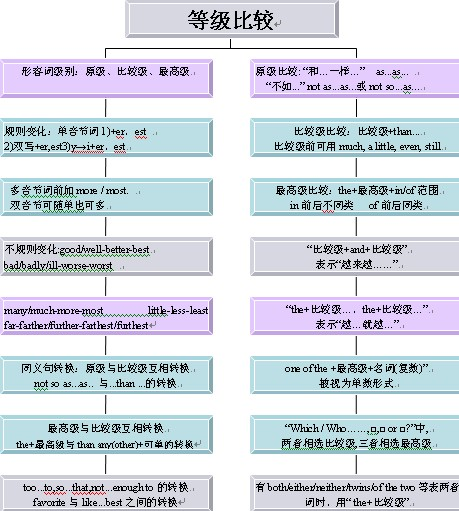
特殊形容词比较级变化:
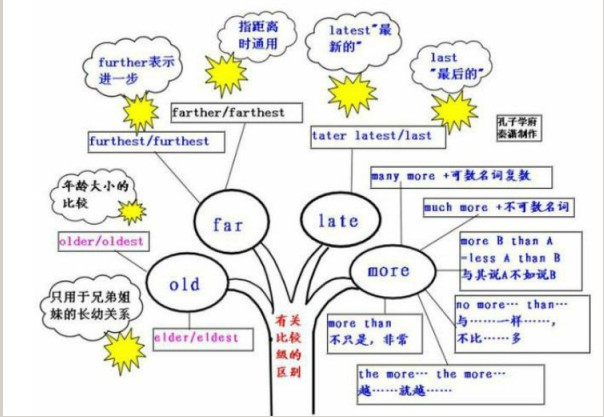
形容词的概念:
形容词(adjective),简称adj.或a,形容词用来修饰名词或代词,表示人或事物的性质、状态,和特征的程度好坏与否,形容词在句中作定语、表语、宾语补足语。通常,可将形容词分成性质形容词和叙述形容词两类,其位置不一定都放在名词前面。
形容词的作用与位置:
形容词是用来修饰名词的,常被放在名词前作定语,或放在系动词后面作表语。以下属几种特殊情况,须牢记;
(1)形容词短语作定语,定语后置。
如:a language difficult to master,
a leaning tower about 180 feet high
(2)表语形容词(afraid、alike、alone、asleep、awake、alive等)作定语,定语后置。如a man alive。有些表身体健康状况的形容词如well、faint、ill只作表语。sick既可作表语又可作定语,ill如作定语意为“bad”。
(3)用作定语,修饰由不定代词one、no、any、some和every构成的复合词如anything、something等时,通常后置。
如:I have something important to tell you.
(4)else常用作疑问代词和不定代词的后置定语。
(5)enough、nearby修饰名词前置或后置,程度副词一般位于形容词、副词前面,enough修饰形容词、副词时,必须后置。
(6)几个并列的形容词作定语,其语序通常为:限定语(The、A)+描绘性形容词+size(大小)+shape(形状)+age(年龄、时间)+color(颜色)+origin(国籍、来源)+material(材料)+purpose(目的)+名词。
口诀:
限定描绘大长高,形状年龄和新老;颜色国籍跟材料,作用类别往后靠。
如:a heavy black Chinese steel umbrella,
the man's first tow interesting little red French oil paintings
形容词的用法:
1、形容词修饰名词,说明事物或人的性质或特征。通常,可将形容词分成性质形容词和叙述形容词两类,其位置不一定都放在名词前面:
1)直接说明事物的性质或特征的形容词是性质形容词,它有级的变化,可以用程度副词修饰,在句中可作定语、表语和补语。例如:hot热的。
2)叙述形容词只能作表语,所以又称为表语形容词。这类形容词没有级的变化,也不可用程度副词修饰。
大多数以a开头的形容词都属于这一类。例如:
afraid害怕的。(错)Heisanillman. (对)Themanisill. (错)Sheisanafraidgirl. (对)Thegirlisafraid.
这类词还有:well,unwell,ill,faint,afraid,alike,alive,alone,asleep,awake等。
3)形容词作定语修饰名词时,要放在名词的前边。但是如果形容词修饰以-thing为字尾的词语时,要放在这些词之后。例如:somethingnice
2、用形容词表示类别和整体:
1)某些形容词加上定冠词可以泛指一类人,与谓语动词的复数连接。如:the dead,the living,the rich,the poor,the blind,the hungry The poorarelosinghope.穷人失去了希望。
2)有关国家和民族的形容词加上定冠词指这个民族的整体,与动词的复数连用。如:the British,the English,the French,the Chinese. The English have wonderful senseofhumor.
以-ly结尾的形容词:
1)大部分形容词加-ly可构成副词。但friendly,deadly,lovely,lonely,likely,lively,ugly,brotherly,仍为形容词。改错:
如:(错)She sang lovely.
(错)He spoke to me very friendly.
(对)Her singing was lovely.
(对)He spoke to me in a very friendly way.
2)有些以-ly结尾既为形容词,也为副词。 daily,weekly,monthly,yearly,early .
如:The Times is a daily paper.
The Times is published daily.
形容词知识体系:

复合形容词的构成:
(1)形容词+名词+ed:
如:kind-hearted 好心的,white-haired 白发的
(2)形容词+形容词:
如:red-hot 炽热的,dark-blue 深蓝的
(3)形容词+现在分词:
如:good-looking 好看的,easy-going 随和的
(4)副词+现在分词:
如:hard-working 勤劳的,fast-moving 快速转动的
(5)副词+过去分词:
如:hard-won 得来不易的,newly-made 新建的
(6)名词+形容词:
如:life-long 终生的,world-famous 世界闻名的
(7)名词+现在分词:
如:peace-loving 爱好和平的,fun-loving 爱开玩笑的
(8)名词+过去分词:
如:snow-covered 白雪覆盖的,hand-made 手工的
(9)数词+名词+ed:
如:four-storeyed 4层楼的,three-legged 3条腿的
(10)数词+名词(名词用单数):
如:ten-year 10年的, two-man 两人的
介词和介词短语的概念:
介词是一种用来表示词与词、词与句之间的关系的虚词,在句中不能单独作句子成分。介词后面一般有名词、代词或相当于名词的其他词类,短语或从句作它的宾语。介词和它的宾语构成介词词组,在句中作状语,表语,补语或介词宾语。介词可以分为时间介词、地点介词、方式介词和其他介词。
误用介词的三种情况:
1、多用介词:
多用介词可能是受汉语意思的影响将及物动词误用作不及物动词,也可能是受相关结构的影响而用错:
误:We discussed about the plan.
正:We discussed the plan. 我们讨论了计划。
误:Did he mention about the accident?
正:Did he mention the accident? 他提到那次事故了吗?
误:I saw her enter into the bank.
正:I saw her enter the bank. 我看见她进了银行。
误:He married with[to] a nurse.
正:He married a nurse. 他同一位护士结了婚。
误:How can contact with you?
正:How can contact you? 我怎么与你联系?
误:We should serve for the people heart and soul.
正:We should serve the people heart and soul. 我们应该全心全意地为人民服务。
误:Who controls over the factory? (但名词control可接over)
正:Who controls the factory? 谁管理这个工厂?
误:He has a great many of friends here. (比较a great number of)
正:He has a great many friends here. 他在这儿有很多朋友。
2、漏用介词:
漏用介词可能是受汉语意思的影响将不及物动词误用作及物动词,或是受相关结构的影响的影响而用错等:
误:This matter is difficult to deal. (deal with=处理)
正:This matter is difficult to deal with. 这事很难处理。
误:He is not a man to be depended.
正:He is not a man to be depended on. 他不是个可靠的人。
误:He took a cup of tea, and went on the story.
正:He took a cup of tea, and wentonwiththestory.他喝了一口茶,又接着讲故事。
误:My mother still regards me a child. (比较consider…as中的as可省略)
正:My mother still regards me as a child. 我母亲还把我当小孩看。
误:They insisted sending a car over to fetch us.
正:They insisted on sending a car over to fetch us.他们坚持要派车来接我们。
误:What he says is worth listening.
正:What he said is worth listening to.他的话值得一听。
3、错用介词:
错用介词的情况比较复杂,可能是因受汉语意思的而错,也可能是因弄不清搭配关系而错,可能是混淆用法而错,也可能是受相关结构的影响而错,可能是忽略语境而错,也可能是想当然的用错:
误:She called on his office yesterday. (call on+人,call at+地点)
正:She called at his office yesterday. 她昨天去了他办公室拜访。
误:He is engaged with a nurse.
正:He is engaged to a nurse.他与一位护士订了婚。
误:The sun rises from the east.
正:The sun rises in the east.太阳从东方升起。
误:Under his help, I finished it in time.
正:With his help, I finished it in time. 在他的帮助下,我及时做完了。
误:During he was in Japan, he visited many places.
正:During his stay in Japan, he visited many places.他在日本期间,参观过许多地方。
误:We are familiar to his character.
正:We are familiar with his character.我们了解他的性格。
误:Help yourself with the fruit.
正:Help yourself to the fruit.吃点水果吧。
介词的宾语:
1、名词或代词作介词宾语:
如:Are you interested in history? 你对历史感兴趣吗?
Don't worry about it. 别为它担心。
注:若是人称代词用作介词宾语,要注意用宾格。
如:No one can sing like her. 没有人能像她那样唱歌。(不能用like she)
2、动名词作介词宾语:
如:He is good at telling stories. 他善于讲故事。
In crossing the street he was run over. 他在穿过马路时被汽车撞倒。
3、过去分词作介词宾语:
如:We can't regard the matter as settled. 我们不能认为这事已经解决。
I take it for granted you have read the book. 我以为你读过这本书。
注:过去分词用作介词宾语通常只见于某些固定结构中,如上面第1句涉及regard…as(认为…是)结构,第2句涉及take sth for granted(认为某事属实)。在其他情况下,介词后通常不直接跟过去分词作宾语,若语义上需要接过去分词(表被动),可换用“being+过去分词”:
如:He went out without being seen by the others.他出去了,没有被其他人看见。
4、从句作介词宾语:
如:He was not satisfied with what she said. 他对她说的不满意。
I'm worried about where he is. 我担心他上哪儿去了。
注:介词后通常不接that从句,遇此情况需考虑用其他结构:
误:He paid no attention to that she was poor.
正:He paid no attention to the fact that she was poor. 他根本不注意她很穷这一事实。
但有个别介词(如except)可接that从句。
比较:I know nothing about him except that he lives next door./I know nothing about him except for the fact that he lives next door. 我只知道他住在隔壁,其它的就不知道了。
5、不定式作介词宾语:
如:I had no choice but to wait. 除了等,我没有别的选择。
He wanted nothing but to stay there. 他只想留在那儿。
They did nothing but complain. 他们老是一个劲地抱怨。
He never did anything but watch TV. 除了看电视,他从不干任何事。
注:(1)介词后接不定式的情形通常只见于but, except等极个别个词。该不定式有时带to,有时不带to,其区别是:若其前出现了动词do,其后的不定式通常不带to;
若其前没有出现动词do,则其后的不定式通常带to。
(2)介词后虽然通常不直接跟不定式作宾语,但却可接“连接代词(副词)+不定式”结构:
如:He gave me some advice on how to do it. 对于如何做这事他给我提了些建议。
6、形容词作介词宾语:
如:Her pronunciation is far from perfect. 她的语音远不是完美的。
In short, we must be prepared. 总而言之,我们要有准备。
Things have gone from bad to worse. 事情越来越糟。
注:(1)有些形容词用作介词宾语可视为其前省略了动名词being:
如:He regarded the situationas(being) serious. 他认为形势严重。
His work is far from(being) satisfactory. 他的工作丝毫不令人满意。
(2)有些“介词+形容词”的结构已构成固定搭配:in full全部地,全面地,无省略地; in private私下地,秘密地; in particular特别地;in general一般地,通常地,概括地; in brief 简言之;in short总之,简言之; in vain徒然地,徒劳无益地;for fee免费地,无偿地; for certain肯定地,确切地;for sure肯定地,确切地; for short为了简短,简称;atl arge自由自在地,逍遥法外; by far…得多
7、副词作介词宾语:
如:I can't stay for long. 我不能久呆。
It's too hot in here. 这里面太热了。
I looked every where except there. 除了那儿,我到处都看过了。
8、数词作介词宾语:
如:The city has a population of four million. 这座城市有四百万人口。
He was among the first to arrive. 他是第一批到的。
9、介词短语作介词宾语:
如:Choose a book from among these. 从这些书中选一本吧。
I saw her from across the street. 我从街的对面望见了她。
注:通常可后接介词短语作宾语的介词是from, till, until, since, except, instead of等。
比较:I took it from the bed. 我从床那儿(或床上)拿的。
I took it from under the bed. 我从床下拿的。
10、复合结构用作介词宾语:
如:She had no objection to Mary marrying him. 她不反对玛丽与他结婚。
She came in with a book in her hand. 她手里拿着一本书走了进来。
All the afternoon he worked with the door locked. 整个下午他都锁着门在房里工作。
介词短语的句法功能:
1、表语:
如:He was with a friend. 他和一个朋友在一起。
Health is above wealth. 健康胜过财富。
This knife is for cutting bread. 这把小刀是用于切面包的。
注:有些介词(如because of)引出的短语通常只用作状语,不用作表语:
误:His absence is because of the rain.
正:His absence is due to the rain. 他因雨未来。
但是,若主语是代词(不是名词),becauseof引出的短语可用作表语:
如:It is because of hard work. 那是因为辛苦工作的原因。
2、状语:
如:Don't touch it with your hands. 别用手去摸它。
Did you do this by design or by accident? 你这样做是有意的还是无意的?
3、定语:
如:This is his reply to your letter. 这是他给你的回信。
This is the best way of doing it. 这是做此事最好的方法。
My love for you is deeper than the sea. 我对你的爱比海深。
4、宾语补足语:
如:I found everythingin good condition. 我发现一切正常。
Her illness kept her in bed for a week. 她因生病在床上躺了一星期。
注:用作宾语补足语的介词短语在相应的被动语态中则为主语补足语:
如:He was regarded as a hero. 他被看成是英雄。
5、宾语:
如:A man stepped out from behind the wall. 一个人从墙后走出来。
He cannot spare anytime except on Sunday. 除星期日外,他抽不出时间。
6、主语:
如:Between6 and 7 suits me. 六点到七点对我比较适合。
After the exams is the time to relax. 考试后是轻松一下的时间。
注:介词短语通常不用作主语,尽管有时也像上面这样用作主语,但通常可视为是在一定的上下文中有所省略:
如:—When are we going to have the next meeting? 我们下次什么时候见面?
—On Tuesday may be convenient. 星期二可能比较方便。
此句中onTuesday虽用作主语,但可视为是其前省略了meeting一词:
即:Meeting during the vacation may be convenient.
并列连词的概念:
连词是一种虚词,它不能独立担任句子成分而只起连接词与词,短语与短语以及句与句的作用。连词主要可分为两类:并列连词和从属连词。并列连词用来连接平行的词、词组和分句。如:and, but, or, nor, so, therefore, yet, however, for, hence, as well as, both...and, notonly...butalso, either...or, neither...nor, (and)then 等等。
并列连词与并列结构:
并列连词引导两个并列的句子。
1)and与or:
判断改错:
(错) They sat down and talk about something.
(错) They started to dance and sang.
(错) I saw two men sitting behind and whisper there.
(对) They sat down and talked about something.
(对) They started to dance and sing.
(对) I saw two men sitting behind and whispering there.
解析:第一句:and连接两个并列的谓语,所以talk应改为talked。
第二句:and连接两个并列的动词不定式,第二个不定式往往省略to,因此sang应改为sing。
第三句:and连接感观动词saw后面的用作的宾补的两个并列分词结构,因此whisper应改为whispering。
注意:and还可以和祈使句或名词词组连用表示条件。(or也有此用法)
如:Make up your mind, and you'll get the chance.=If you make up your mind, you'll get the chance.
One more effort, and you'll succeed.=If you make one more effort, you'll succeed.
2)both...and 两者都
如:She plays(both) the piano and the guitar.
3)not only...but(also), as well as 不但…而且
如:She plays not only the piano, but(also) the guitar.
注意:not only…but also关联两个分句时,一个分句因有否定词not而必须倒装。
如:Not only does he like reading stories, but also he can even write some.
4)neither...nor 意思为“既不……也不……”谓语动词采用就近原则,与nor后的词保持一致。
如:Neither you nor he is to blame.
比较so和such :
so与such的用法由不同词性决定。such是形容词,修饰名词或名词词组,so是副词,只能修饰形容词或副词。so还可与表示数量的形容词many,few,much,little连用,形成固定搭配。
构成:so+adj.
such+a(n)+n.
so+adj.+a(n)+n.
such+n.(pl.)
so+adj.+n.(pl.)
such+n.(pl.)
so+adj.+n.[不可数]
such+n.[不可数]
如:so foolish
such a fool
so nice a flower
such a nice flower
so many/few flowers
such nice flowers
so much/ little money.
such rapid progress
so many people
such a lot of people
注:so many 已成固定搭配,a lot of 虽相当于many,但a lot of为名词性的,只能用such搭配。 so...that与such...that之间的转换既为so与such之间的转换。
并列连词用法点拨:
1、表示并列关系:
1)or意思为“否则”。
如:I must work hard, or I'll fail in the exam.
2)either...or意思为“或者……或者……”。注意谓语动词采用就近原则。
如:Either you or I am right.
2、表示转折或对比关系:
1)but表示转折,while表示对比。
如:Some people love cats, while others hate them.
典型例题:
—Would you like to come to dinner tonight?
—I'd like to, ___ I'm too busy.
A. and
B. so
C. as
D. but
答案:D。but与前面形成转折,符合语意。而表并列的and,结果的so,原因的as都不符合句意。
2)not...but...意思为“不是……而是……” not和but后面的用词要遵循一致原则。
如:They were not the bones of an animal, but(the bones) of a human being.
3、表示原因关系:
1)for 判断改错:
(错)For he is ill, he is absent today.
(对)He is absent today, for he is ill. for是并列连词,不能置于含两个并列分句的句子的句首,只能将其放在两个分句中间。
并列连词知识体系:
| 种类 | 用法 | 举例 |
| 并列连词 | 表示转折关系 | yet, but等 |
| 表示并列关系 | and, or, either...or..., as welll as等 | |
| 表示因果关系 | for, so等 |
比较and和or的用法:
1)并列结构中,or通常用于否定句,and用于肯定句。
2)但有时and也可用于否定句。请注意其不同特点:
如:There is no air or water in the moon.
There is no air and no water on the moon.
在否定中并列结构用or连接,但含有两个否定词的句子实际被看作是肯定结构,因此要用and。
典型例题:
—I don't like chicken___fish.
—I don't like chicken, ___I like fish very much.
A. and;and
B. and;but
C. or;but
D. or;and
答案:C。否定句中表并列用or,but表转折。
判断改错:
(错)We will die without air and water.
(错)We can't live without air or water.
(对)We will die without air or water.
(对)We can't live without air and water.
一般过去时的概念:
一般过去时表示过去某个时间里发生的动作或状态;过去习惯性、经常性的动作、行为;过去主语所具备的能力和性格。
一般过去时的用法:
1、表示过去发生的动作或存在的状态,常与表示过去时间的副词如:yesterday,last week,two hours ago等连用。
如:My family moved here five years ago. 我家五年前搬到了这里。
I was born in 1973. 我生于1973年。
2、表示过去一段时间经常或反复发生的动作。这时可与频度副词如:often,usually,always等连用。
如:He always worked in tonight those days. 那些日子他总是工作到深夜。
I often left on business in 1987. 1987年我经常出差。
注:表示“过去经常,而今不再”时,要用usedto.
如:I used to read newspaper after breakfast. 我过去经常早饭后看报纸。(意指现在已不是这样)
The children often swam in this river. 孩子们过去经常在这条河里游泳。
3、表示过去发生的一连串动作。
如:He put down the heavy box, took out the keys, and opened the door. 他放下这沉重的箱子,掏出钥匙开了房门。
注:过去发生的一连串动作,若用and,or,but等并列连词连接,则一律用过去式。
如:They moved the chairs to the table, sat down and began to have supper. 他们把椅子搬到桌边,坐下开始吃饭。
4、在时间和条件状语从句中,用一般过去时表示过去将来的动作。
如:He said that he would let me know as soon as he got the information. 他说他一得到消息就立即让我知道。
Mary told me that she would stay at home if it rained. 玛丽告诉我如果下雨她就呆在家里。
一般过去时的特别用法:
1、句型:It is time for sb. to do sth "到……时间了" "该……了"。
例如:It is time for you to go to bed.你该睡觉了。
It is time that sb.did sth. "时间已迟了" "早该……了"。
例如:It is time you went to bed. 你早该睡觉了。
2、would(had)rather sb.did sth. 表示'宁愿某人做某事'。
例如:I'd rather you came tomorrow. 还是明天来吧。
3、wish, wonder, think, hope等用过去时,作试探性的询问、请求、建议等,而一般过去时表示的动作或状态都已成为过去,现已不复存在。
例如:I thought you might have some. 我以为你想要一些。
比较:Christine was an invalid all her life.(含义:她已不在人间。)
Christine has been an invalid all her life.(含义:她现在还活着)
Mrs. Darby lived in Kentucky for seven years.(含义:达比太太已不再住在肯塔基州。)
Mrs. Darby has lived in Kentucky for seven years.(含义:现在还住在肯塔基州,有可能指刚离去)
注意:用过去时表示现在,表示委婉语气。
1)动词want, hope, wonder, think, intend等。
例如:Did you want any thing else? 您还要些什么吗?
I wondered if you could help me. 能不能帮我一下。
2)情态动词could, would。
例如:Could you lend me your bike? 你的自行车,能借用一些吗?
主谓一致的概念:
谓语的数必须和主语的人称和数保持一致,这就叫主谓一致。
主谓一致的基本原则:
1)语法一致原则,即在语法形式上取得一致。例如,主语是单数形式,谓语动词也采取单数形式;主语是复数形式,谓语动词也采取复数形式。
例如:The students are very young.
This picture looks beautiful.
2)意义一致原则,即从意义着眼处理一致关系。例如,主语形式虽是单数但意义是复数,谓语动词也采取复数形式;
而有些主语形式虽是复数但意义上看作单数,谓语动词也采取单数形式。
例如:The people in that country are fighting for independence.
The crowd deeply respect their leader.
Three years in a strange land seems a long time.
3)就近原则,即谓语动词的单数或复数形式取决于最靠近它的词语。
例如:Neither hen or I am going to see the film tonight because we are busy.
几对容易混淆词组的一致用法:
1、由“this/thatkind/typeof+名词”作主语,谓语动词用单数形式;而由"these/thosekind/typeof+复数名词”作主语,谓语动词用复数形式。
例如:This kind of apples is highly priced.
Those kind(s) of tests are good.
2、由“a number of,a totalo f,an average of+复数名词”作主语,谓语动词用复数形式;由“the number of,the total of,the average of+复数名词”作主语,谓语动词用单数形式。
例如:A number of students are waiting for the bus.
The number of the students in this university is increasing yearly.
3、one of,the(only) one of的一致用法
例如:This is one of the books that have been recommended.
This is the(only) one of the books that has been recommended.
主谓一致用法点拨:
1、并列结构作主语谓语用复数:
如:Reading and writing are very important.
注意:当主语由and连结时,如果它表示一个单一的概念,即指同一人或同一物时,谓语动词用单数,and此时连接的两个词前只有一个冠词。
如:The iron and steel industry is very important to our life.
典型例题:
The League secretary and monitor___asked to make a speech at the meeting.
A. is
B. was
C. are
D. were
答案:B.
注:先从时态上考虑。这是过去发生的事情应用过去时,先排除A、C本题易误选D,因为The League secretary and monitor 好象是两个人,但仔细辨别,monitor前没有the,在英语中,当一人兼数职时只在第一个职务前加定冠词。后面的职务用and相连。这样本题主语为一个人,所以应选B。
2、主谓一致中的靠近原则:
1)当there be句型的主语是一系列事物时,谓语应与最邻近的主语保持一致。
例如:There is a pen, a knife and several books on the desk.
There are twenty boy-students and twenty-three girl-students in the class.
2)当either…or…与neither…nor,连接两个主语时,谓语动词与最邻近的主语保持一致。
如果句子是由here, there引导,而主语又不止一个时,谓语通常也和最邻近的主语一致。
例如:Either you or she is to go.
Here is a pen, a few envelops and some paper for you.
3、谓语动词与前面的主语一致:
当主语后面跟有with, together with, like, except, but, no less than, as well as等词引起的短语时,谓语动词与前面的主语一致。
例如:The teacher together with some students is visiting the factory.
He as well as I wants to go boating.
4、谓语需用单数:
1)代词each和由every, some, no, any等构成的复合代词作主语,或主语中含有each,every,谓语需用单数。
例如:Each of us has a tape-recorder.
2)当主语是一本书或一条格言时,谓语动词常用单数。
例如:The Arabian Night is a book known to lovers of English.
3)表示金钱,时间,价格或度量衡的复合名词作主语时,通常把这些名词看作一个整体,谓语一般用单数。(用复数也可,意思不变。)
例如:Three weeks was allowed for making the necessary preparations.
Ten yuan is enough.
5、指代意义决定谓语的单复数:
1)在代词what, which, who, none, some, any, more, most, all等词的单复数由其指代的词的单复数决定。
例如:All is right. (一切顺利。)
All are present. (所有人都到齐了。)
2)集体名词作主语时,谓语的数要根据主语的意思来决定。
例如:family, audience, crew, crowd, class, company, committee等词后用复数形式时,意为这个集体中的各个成员,用单数时表示该个集体。
例如:His family isn't very large. 他家不是一个大家庭。
His family are music lovers. 他的家人都是音乐爱好者。
但集合名词people, police, cattle, poultry等在任何情况下都用复数形式。
例如:Are there any police around?
3)有些名词,如variety, number, population, proportion, majority等有时看作单数,有时看作复数。
A number of+名词复数+复数动词。 The number of+名词复数+单数动词。
例如:A number of books have lent out.
The majority of the students like English.
6、与后接名词或代词保持一致:
1)用half of, part of, most of, a portion of等词引起主语时,动词通常与of后面的名词,代词保持一致。
例如:Most of his money is spent on books.
Most of the students are taking an active part in sports.
2)在一些短语,如many a或more than one所修饰的词作主语时,谓语动词多用单数形式。
但由more than…of作主语时,动词应与其后的名词或代词保持一致。
例如:Many a person has read the novel. 许多人都读过这本书。
More than 60percent of the students are from the city. 百分之六十多的学生都来自这个城市
主谓一致知识体系:
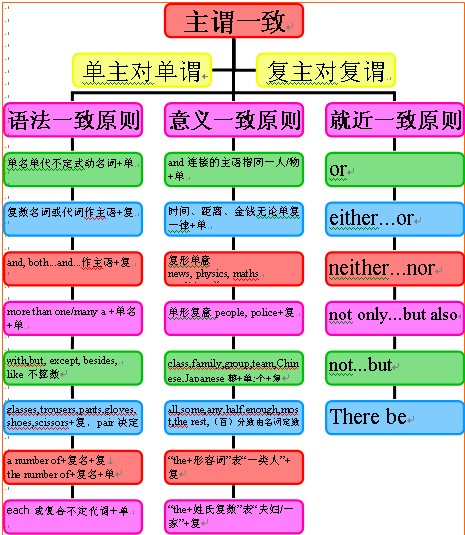
主谓一致用法拓展:
1)当everyone,everybody,noone,nobody,anyone,anybody,someone,somebody,everything,anything,something,nothing等用作主语时,其相应的代词一般用单数形式。
例如:If anybody calls, tell him that I'm out.
Something strange happened, didn't it?
2)人称代词与名词的呼应:人称代词I(me),he(him),she(her),it(it) 都是代替前面的单数名词,而they(them),we(us)则是代替复数名词的,you既可以代表单数,也可以代表复数。但表示泛指的时候,用he或one来表示。
例如:If a young person enters a classical music field only for money, he is in the wrong profession.
3)物主代词与名词的呼应:my,our,his,her,its,their要与代替的名词在数上一致。
例如:The welfare department,as well as the other social services,will have its budget cut.
4)反身代词与其所代成分间的呼应。
例如:Many primitive people believed that by eating ananimal they could get some of the good qualities of that animal for themselves.
5)指示代词与所代名词间的呼应:this和that指代单数名词或不可数名词,these和those指代复数名词(those还可以用作先行词,引导定语从句,表示“那些人”)。
例如:She invited all those who had been her former colleagues.
6)much和muchof后接不可数名词,而many和manyof后接可数名词的复数。
例如:There is not much coal left.
A great many of the houses were knocked down by the earthquake.
7)表示量的词后面有的接可数名词,有的接不可数名词。
接可数名词的有:a number of,a rangeof,a series of十复数名词;
接不可数名词的有:a great deal of,an amount of十不可数名词;
既可接可数又可接不可数名词的有:a lot of,a variety of。
例如:1.The government attached a great deal of importance to education.
2.Quiteanumberofwomenappliedforthisjob.
3.The college library has avariety of books.
4.An apple is avariety off ruit.
与“短文改错。假定英语课上老师要求同桌之间交换修改作文,请你...”考查相似的试题有:
- There are better drugs to cure this disease, but not all patients have to them.[ ]A. accessB. waysC. methodsD. measures
- As an average student, I'm _____ to know the result of the exam, for I'm _____ to be admitted into theuniversity.[ ]A...
- There are plenty of jobs in the western part of the country.[ ]A.presentB.availableC.preciousD.convenient
- As it was almost time for the flight, all the passengers got ______ the plane.A.aroundB.abroadC.aboardD.ahead
- Could you wait a few days to see what we'll make __ you __ your own measure, madam?A.to, forB.for, toC.to, withD....
- I was enjoying my dessert and talking to my American friend Janice at the table _____ I noticed peoplestaring at us.A...
- Just use this room for the time being, and we'll offer you a larger one ________ it becomes available.(2010·安徽)A.a...
- One-third of the country____covered with trees and the majority of the citizens_______black people.A is;are B is;is...
- of the land in my hometown covered with trees and grass.A.Two fifth ; isB.Two fifth ; areC.Two fifths ; isD.Two f...
- I feel it is you rather than the boy who________for being late for the speech.[ ]A. is to blameB. are to blameC. is t...